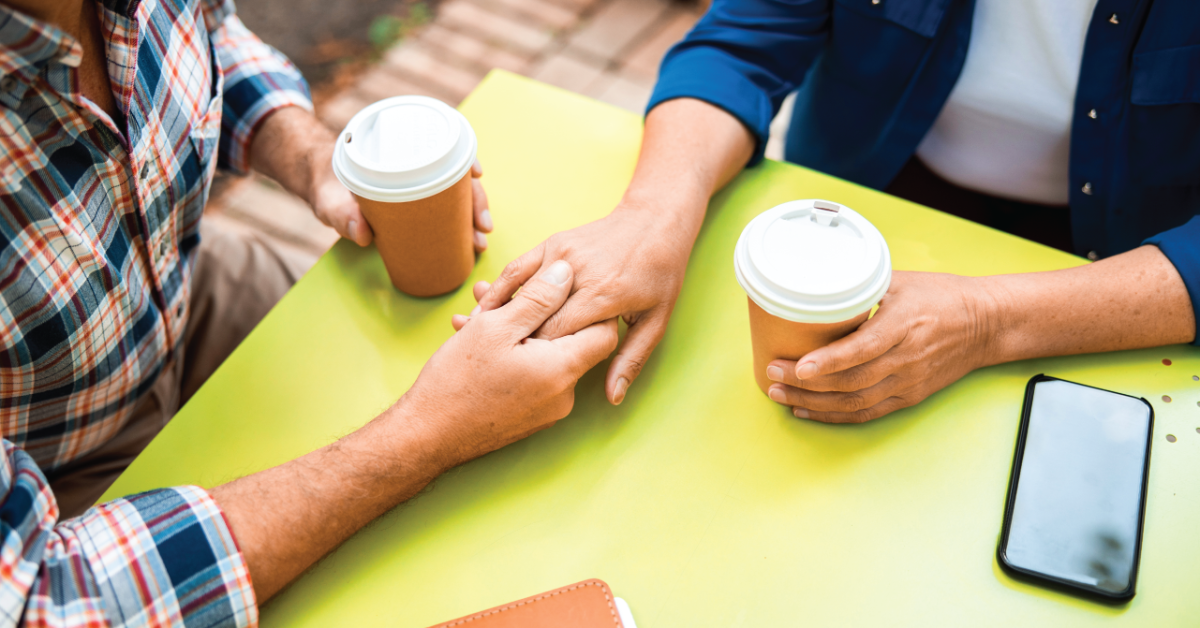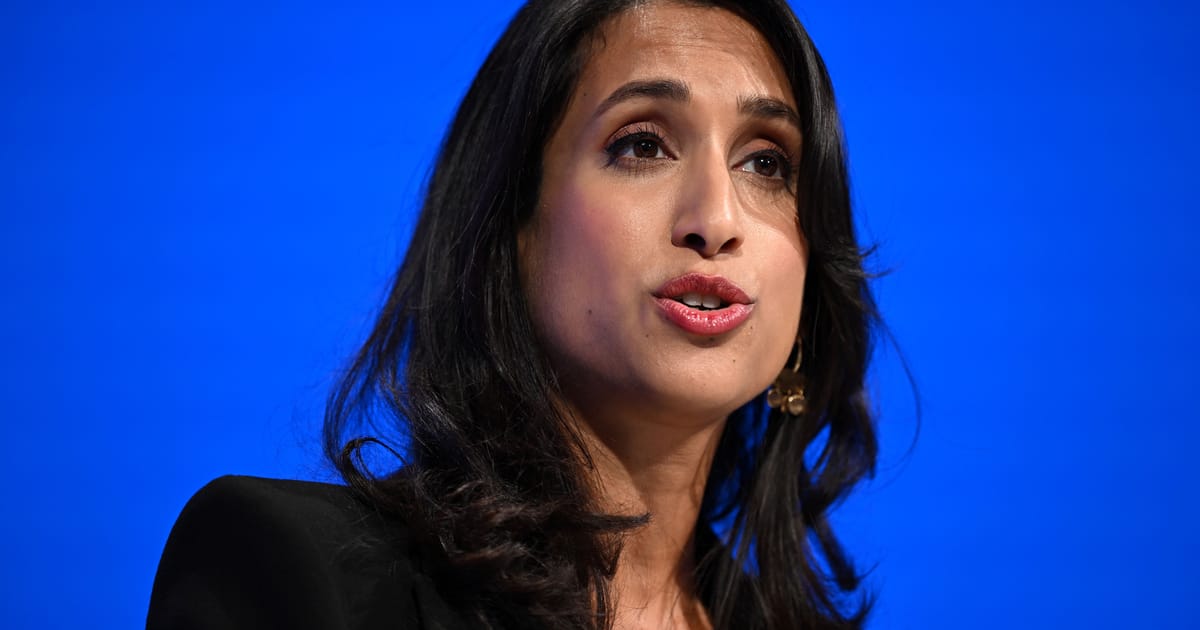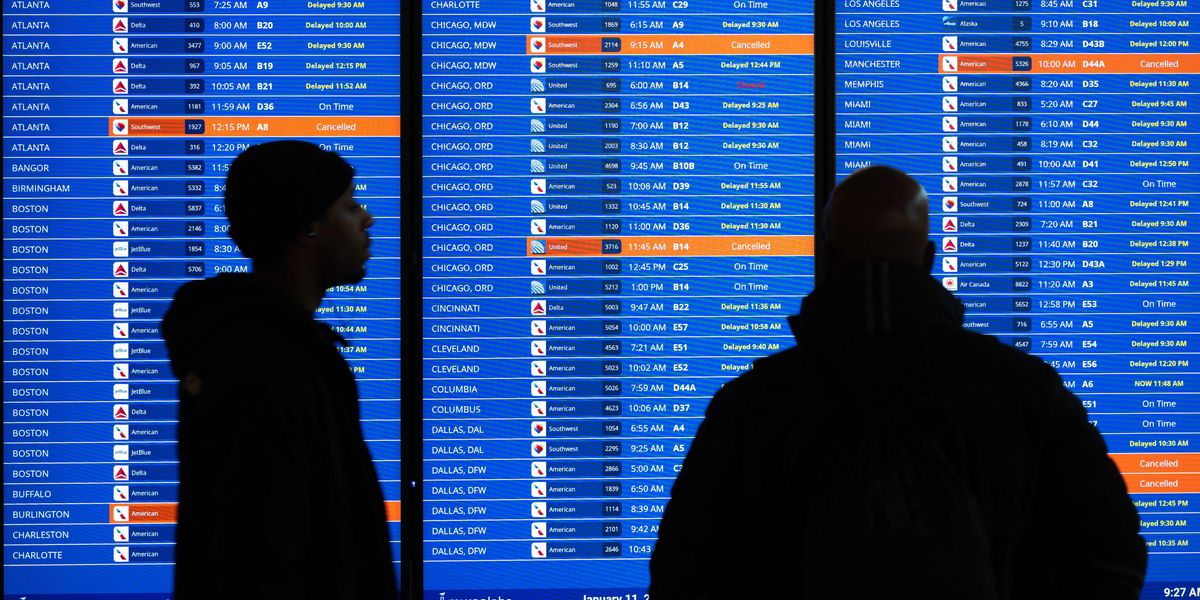Tinder is the most widely used dating platform in the U.S. About half of those who have used dating sites or apps have had positive experiences, and some have met their partners on one. But safety and harassment remain issues
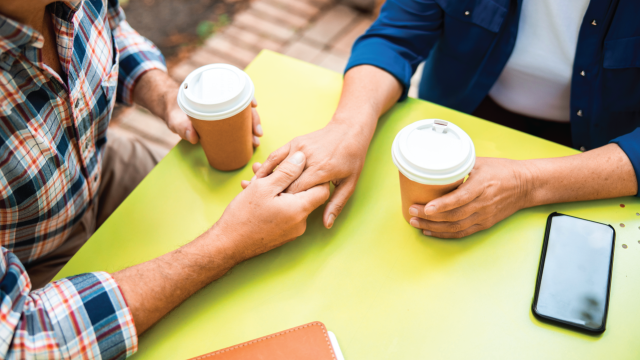
Pew Research Center conducted this study to understand Americans’ experiences with dating sites and apps and their views of online dating generally. This survey was conducted among 6,034 U.S. adults from July 5-17, 2022. This included 4,996 respondents from the Center’s American Trends Panel (ATP), an online survey panel that is recruited through national, random sampling of residential addresses. This way nearly all U.S. adults have a chance of selection. It also included an oversample of 1,038 respondents from Ipsos’ KnowledgePanel who indicated that they are lesbian, gay or bisexual (LGB), with oversampled groups weighted back to reflect proportions in the population. The survey is weighted to be representative of the U.S. adult population by gender, race, ethnicity, partisan affiliation, education and other categories. Read more about the ATP’s methodology.
Here are the questions used for this analysis, along with responses, and its methodology.
A note about the Asian adult sample
This survey includes a total sample size of 234 Asian adults. The sample primarily includes English-speaking Asian adults and, therefore, may not be representative of the overall Asian adult population. Despite this limitation, it is important to report the views of Asian adults on the topics in this study. As always, Asian adults’ responses are incorporated into the general population figures throughout this report. Asian adults are shown as a separate group when the question was asked of the full sample. Because of the relatively small sample size and a reduction in precision due to weighting, results are not shown separately for Asian adults for questions that were only asked of online dating users or other filtered questions. We are also not able to analyze Asian adults by demographic categories, such as gender, age or education.
Whether searching for “the one” or “the right now,” Americans are turning to the internet to help them find companionship, commitment or casual encounters. Three-in-ten U.S. adults say they have ever used a dating site or app, according to a Pew Research Center survey conducted July 5-17, 2022. Their experiences range from triumphant to troubling, as some report meeting a partner online or being excited about prospects, while others report facing harassment or scams.
People have a number of dating sites and apps to choose from in today’s market. Tinder is the most commonly used dating site or app among the list of eight measured in the survey. Some 46% of Americans who have ever used a dating site or app say they have used it, which represents 14% of all U.S. adults.
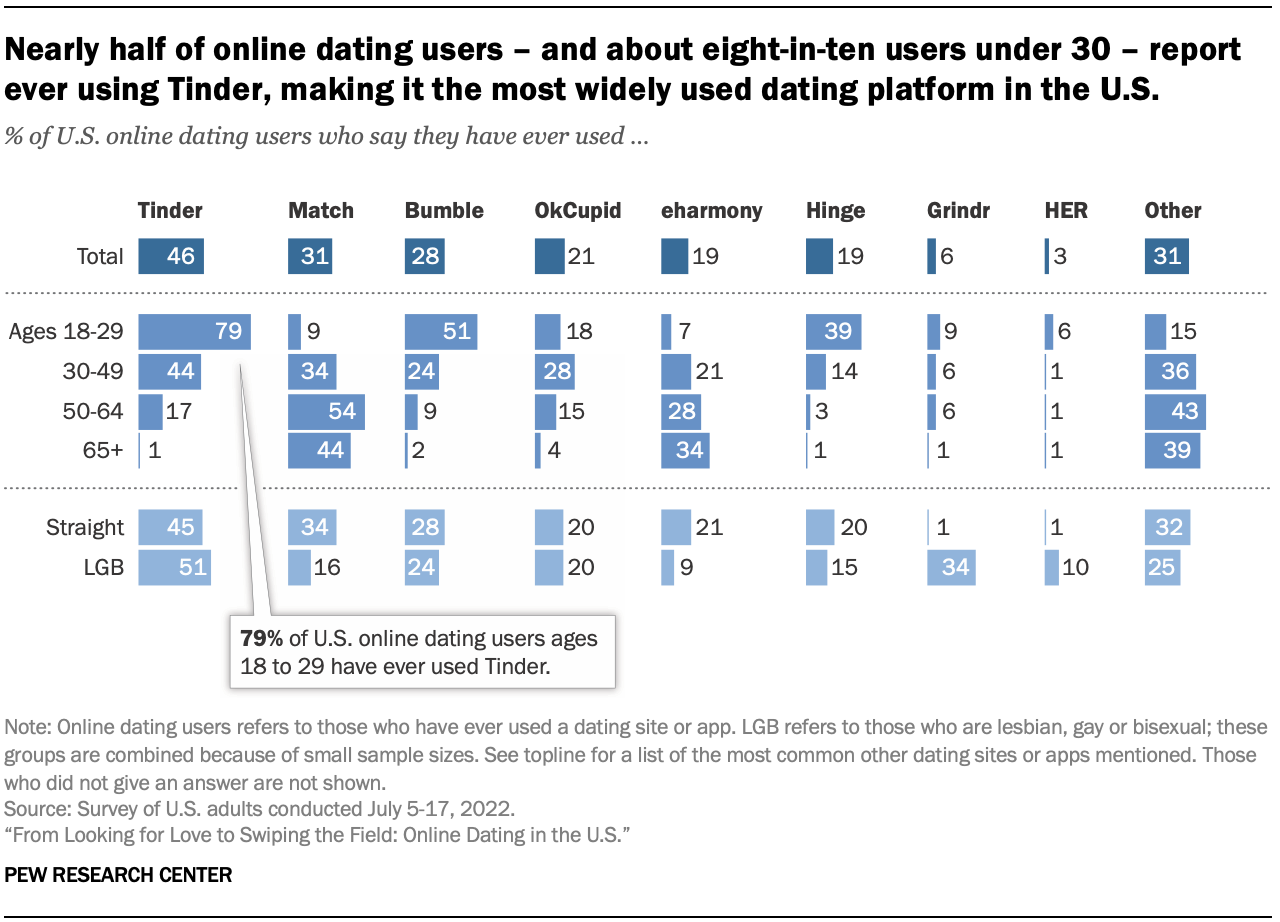
About three-in-ten online dating users – equaling roughly one-in-ten adults overall – report ever using Match or Bumble. OkCupid, eharmony and Hinge have each been used by roughly one-in-five online dating users (6% each among all adults).
While Grindr and HER are used by small shares of online dating users overall, they are far more popular among lesbian, gay or bisexual (LGB) online dating users. Some 34% of LGB users say they have ever tried Grindr and 10% say this about HER.
And owing to the wide range of dating platforms available to Americans, about three-in-ten online dating users say they have ever used another dating site or app not on this list (see Chapter 1 of this report for a discussion of these responses).
The dating sites and apps people have used also vary widely by age. For example, 79% of online dating users under 30 say they have used Tinder, versus 44% of those ages 30 to 49 and smaller shares of those 50 and older. On the other hand, Match is more popular among online dating users 50 to 64 than among those in other age groups.
Like the Center’s 2019 study, this survey primarily explored the experiences of online dating users in general – that is, no matter what platforms they have used. The overall share of Americans who report using any type of dating site or app – 30% – is unchanged since the last time the Center studied this topic. As was true then, some groups are more likely to have tried online dating than others.
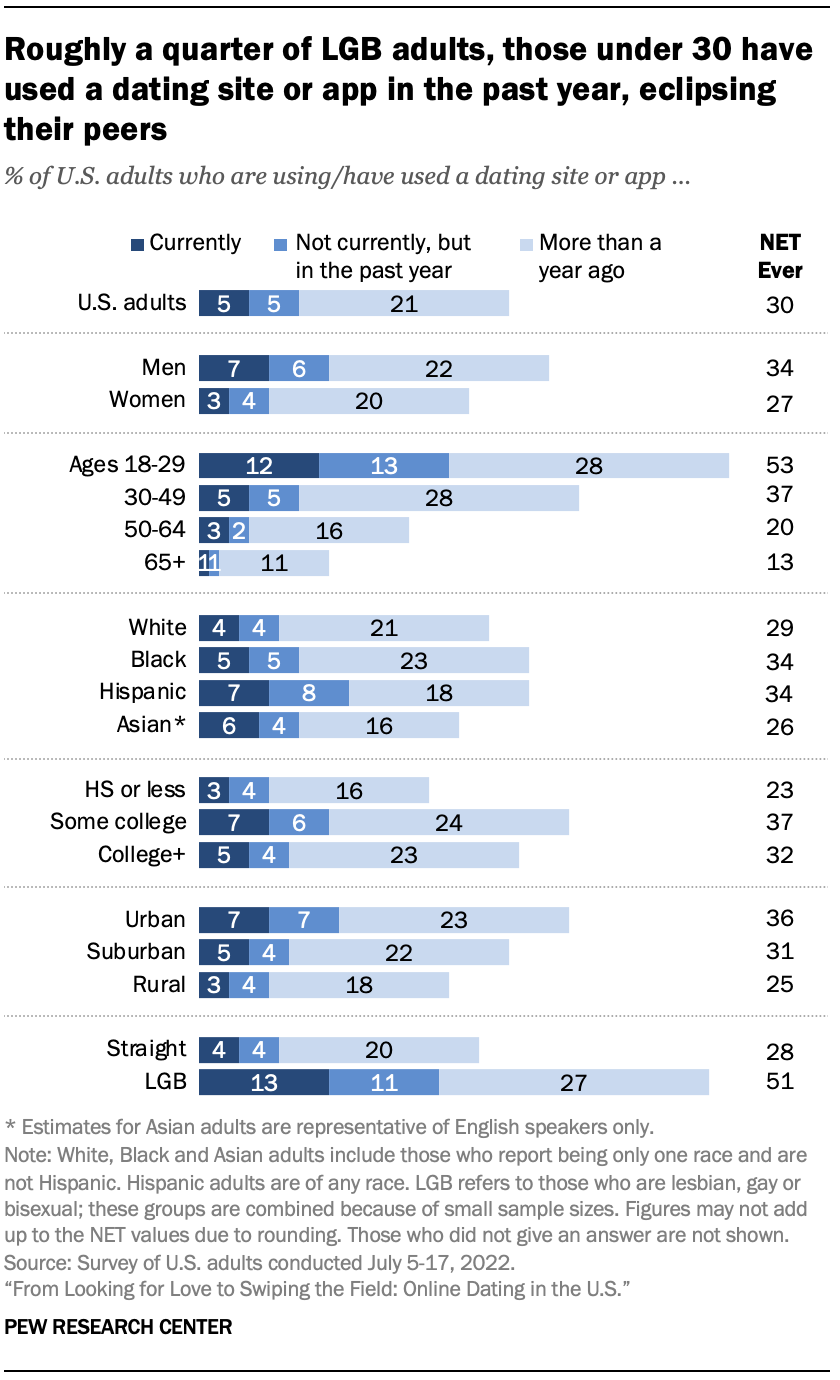
Some 53% of adults under 30 have ever used a dating site or app – including a quarter who have used one in the past year. This compares with 37% of those ages 30 to 49 who have ever tried online dating and smaller shares of those 50 to 64 (20%) and 65 and older (13%) who say the same.
Beyond age differences, LGB adults stand out for their use of dating sites and apps: 51% of this group have used one, including 24% who have in the past year.
There are also more modest differences by community type, education and gender. Similar shares of Americans across racial and ethnic groups say they have ever used a dating site or app.
The upsides and downsides of dating digitally have inspired considerable debate. One of the key questions surrounding online dating is whether these platforms lead to long-term relationships.
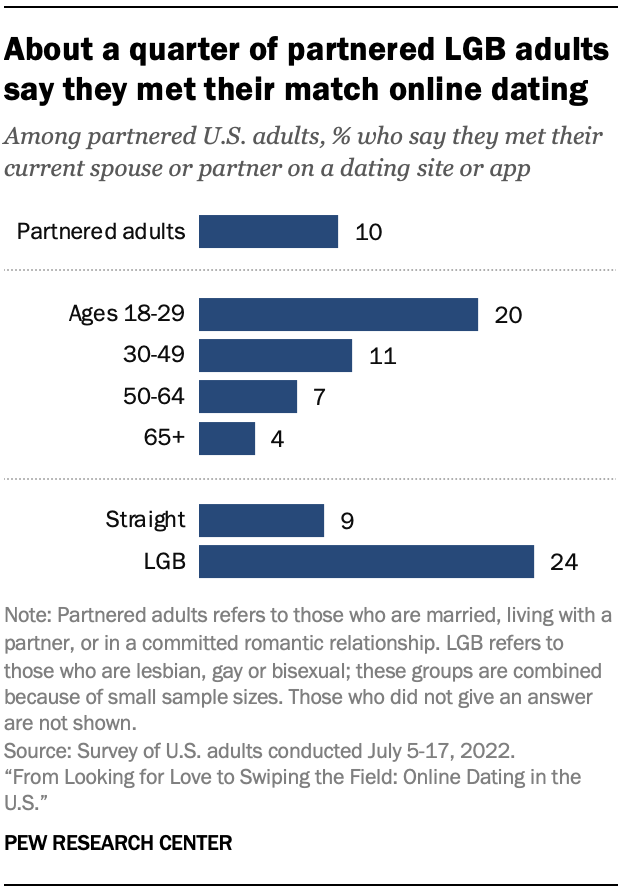
One-in-ten adults who are partnered – that is, they are married, living with a partner or in a committed romantic relationship – say they met this person on a dating site or app. The share rises to 20% of partnered adults under 30 who say online dating brought them together; about a quarter of LGB partnered adults say the same.
Even so, Americans overall have divided views on some aspects of online dating. For example, not everyone thinks this is a safe way to meet people. About half (48%) say dating sites and apps are a very or somewhat safe way to meet people, while 49% say they are not at all or not too safe.
And the experiences of online dating users, themselves, are also mixed. About half describe their experiences as positive. But some 48% report that their experience on dating sites or apps has included at least one of four unwanted behaviors the survey explored: receiving unsolicited sexual messages or images, experiencing unwanted continued contact, being called an offensive name or being physically threatened.
These are among the major findings from the nationally representative Pew Research Center survey of 6,034 U.S. adults, conducted from July 5-17, 2022. The following are additional key insights from the survey.
Terminology
Throughout this report, the following terms related to online dating and relationships are used:
- Online dating users refers to the 30% of Americans who answered yes to the following question: “Have you ever used an online dating site or dating app?”
- Current or recent online dating users refers to the 9% of adults who had used a dating site or app in the past year as of the July survey.
- Partnered refers to the 69% of U.S. adults who describe themselves as married, living with a partner, or in a committed romantic relationship.
- Single and looking refers to the 13% of U.S. adults who do not describe themselves as married, living with a partner or in a committed romantic relationship and who are looking for a committed romantic relationship only, casual dates only, or either of these things.
Roughly half of those who have used dating sites or apps say experiences have been positive and about a third have paid to use a platform
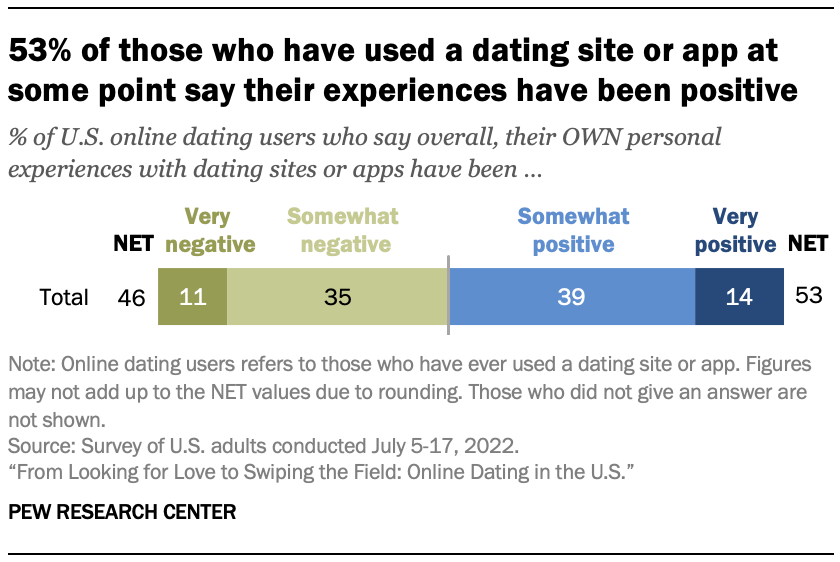
Asked to describe their experiences overall, Americans who have tried online dating are somewhat divided over whether their time on these platforms has been for the better or the worse. Some 53% of online dating users say their experiences have been at least somewhat positive, including 14% who say they have been very positive. A slightly smaller share (46%) say their experiences have been very or somewhat negative overall.
These experiences vary by demographics like gender, race and ethnicity, household income and sexual orientation. For example, men are more likely than women to report positive experiences (57% vs. 48%); LGB users are more likely than straight users to say the same (61% vs. 53%). There has been no change in the overall shares of online dating users who say their experiences have been positive or negative since 2019, though there have been a few small shifts among demographic groups.
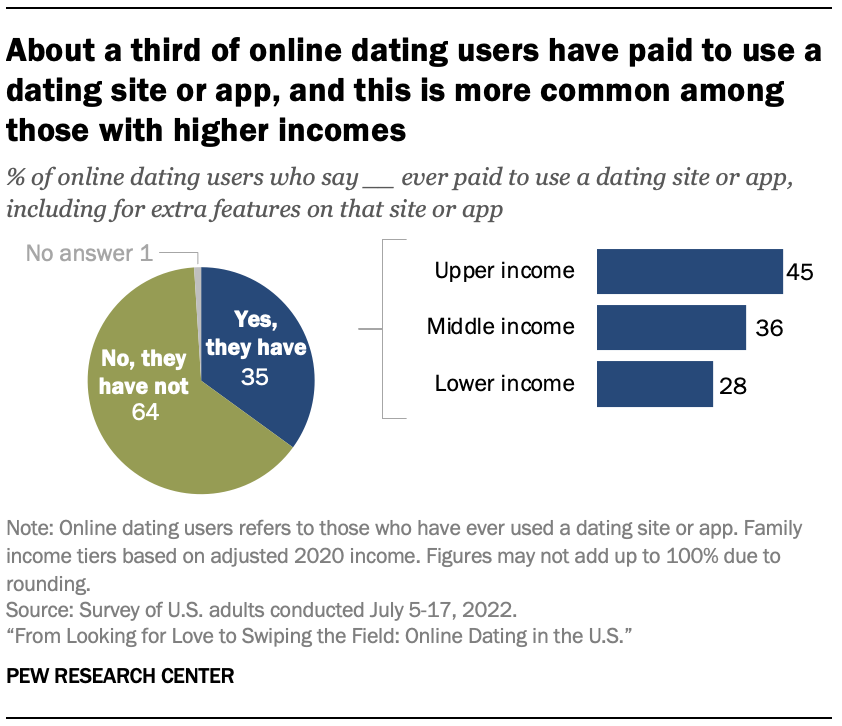
A number of aspects of the online dating experience can come with a price tag, as dating sites and apps offer paid versions or features – like being able to see who likes you or getting extra time to message someone. Some 35% of Americans who have ever used a dating site or app have paid to use one at some point, which includes those who have paid for extra features on a platform they already were using.
This share is greater among online dating users with upper incomes (45%) than for those with middle (36%) or lower incomes (28%).
Experiences with harassment, scams on dating sites differ by gender, age
The survey further explored users’ encounters with those who have less-than-noble intentions while on dating sites and apps – including those who harass or scam users.
Some 38% of online dating users have been sent a sexually explicit message they didn’t ask for on dating sites or apps; 30% have had someone continue to contact them after they said they were not interested; 24% have been called an offensive name; and 6% have had someone threaten to physically harm them. All told, about half of those who have ever used dating sites or apps (48%) say they have experienced at least one of these four unwanted behaviors.
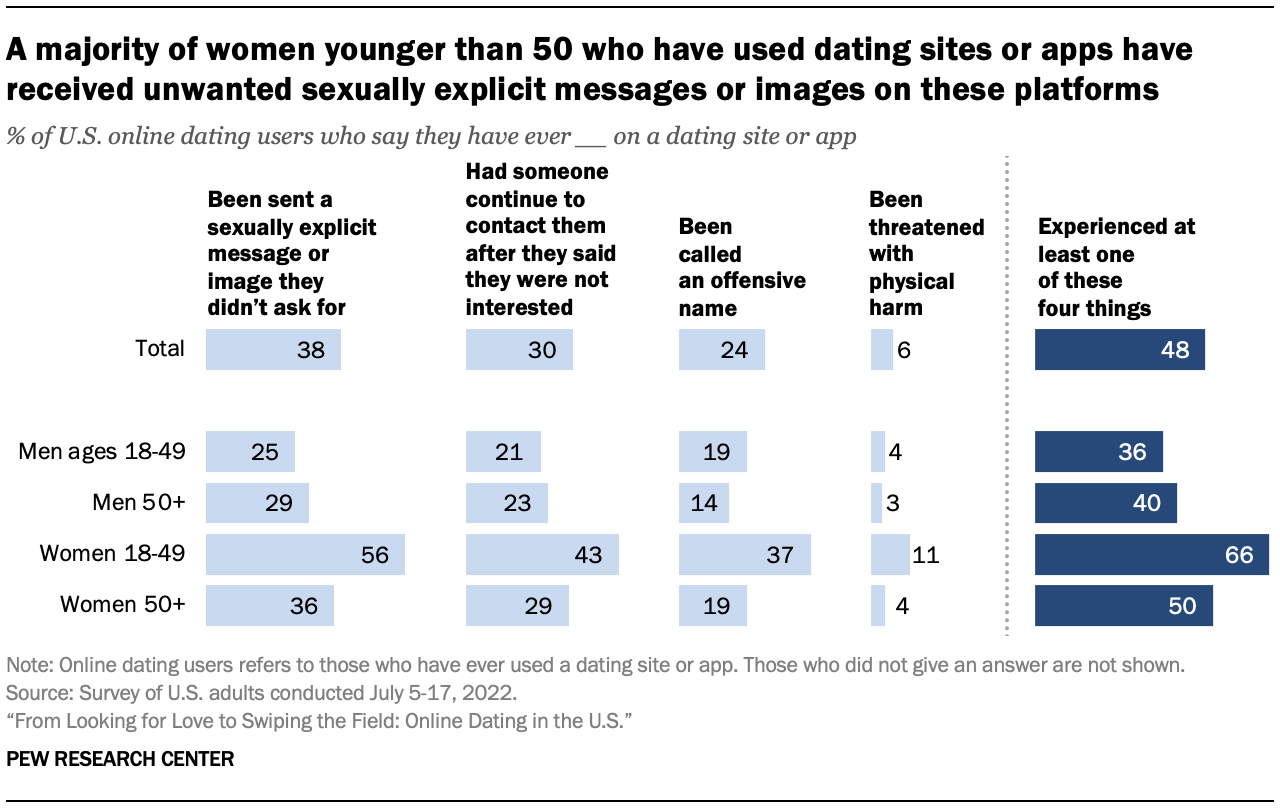
Women are more likely than men to have experienced each of these four behaviors on dating sites and apps that were covered in the survey, and this is largely driven by women under 50. Some 56% of women under 50 who have ever used a dating site or app have been sent unwanted sexually explicit content and about four-in-ten each have been contacted after they said they were not interested (43%) or called an offensive name (37%). Some 11% of this group have been threatened with physical harm on a dating site or app.
All told, about two-thirds (66%) of women under 50 who have tried online dating have experienced at least one of these four unwanted behaviors the survey explored.
LGB users are also particularly likely to experience these things while on dating sites and apps: 64% have faced at least one of the four unwanted experiences the survey covered compared with a smaller share of straight users (45%). Specifically, they are more likely than straight users to say they have ever received unwanted sexual messages or images (56% vs. 34%), experienced unwanted continued contact (42% vs. 28%), or been called offensive names (33% vs. 22%).
Black users are also more likely than White users to say they have received unwanted sexual images or messages (47% vs. 35%), while Hispanic users are more likely to report receiving physical threats than their White counterparts (11% vs. 4%). There are no differences by race or ethnicity in receiving continued unwanted contact or being called offensive names.
Aside from harassment, scams are also a potential concern on dating sites. Some 52% of online dating users think they have encountered a scammer while using them, and this varies by age and gender. Among online dating users, a majority of men under 50 (63%) say they have come across a potential scammer, compared with smaller shares of men 50 and older (47%) or women of any age (44%).
Men and women who have used dating platforms in past year differ in their reactions to how many messages they have gotten in that time
Some 9% of Americans report using a dating site or app in the past year as of the July survey, and these current or recent users express a mix of emotions about who they see on the platforms and how communications flow on them.
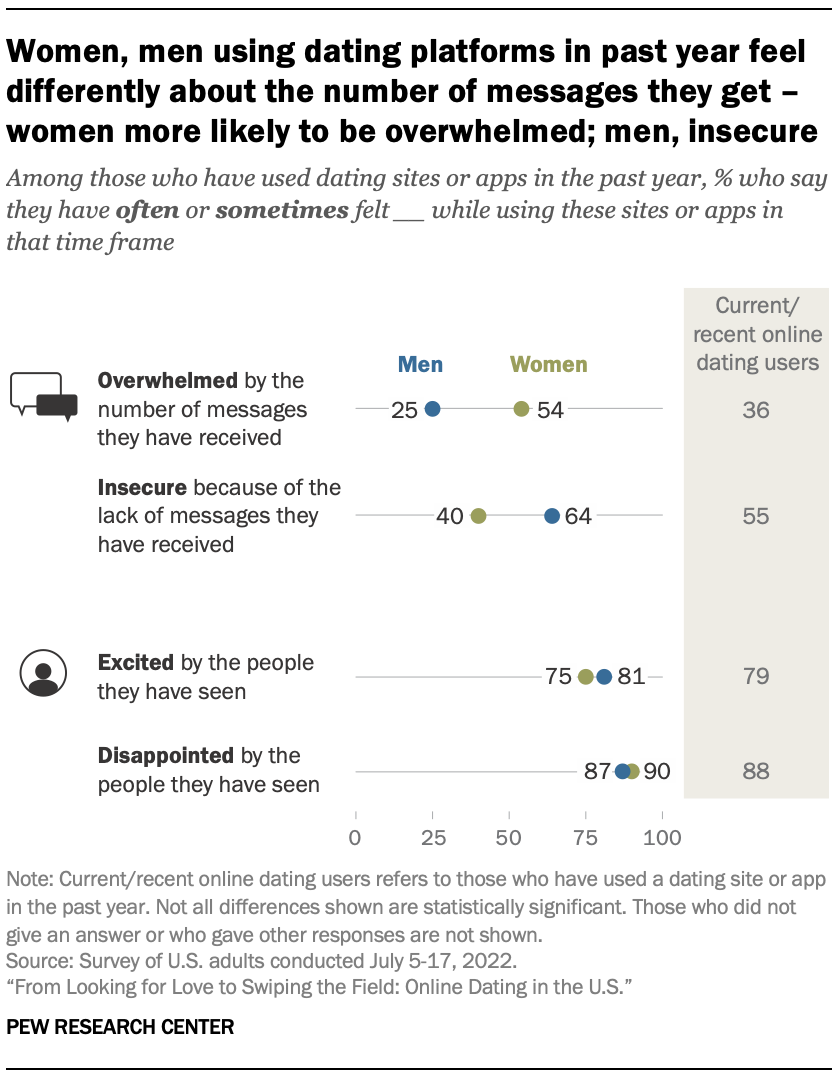
Vast majorities of current or recent online dating users say they have been disappointed (88%) and excited (79%) at least sometimes by people they have seen on the platforms over the past year. This is true regardless of gender. For example, 81% of men and 75% of women report at least some excitement over the people they have encountered recently on dating sites and apps.
But when it comes to actually connecting with people, not everyone is happy with the amount of messages they get.
Some 55% of current or recent users say they have at least sometimes been insecure because of the lack of messages they have received in the past year, with this feeling far more common among men than women (64% vs. 40%). On the flip side, 36% of these current or recent users say they are overwhelmed by the number of messages at least sometimes, and this is far more common among women than men (54% vs. 25%).
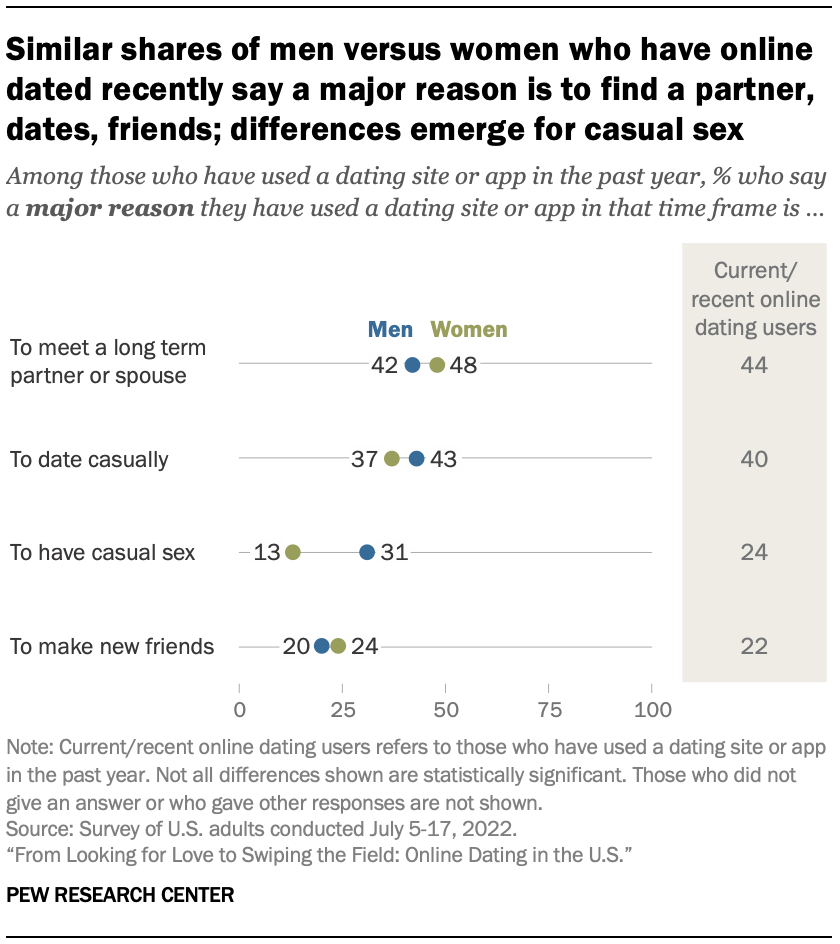
When it comes to four potential reasons why people might be on dating platforms, 44% of current or recent users say a major reason they are there is to find a long-term partner and a similar share (40%) say this about dating casually. Smaller shares say this about having casual sex (24%) or finding new friends (22%).
Men and women do not differ on three of these four reasons, but casual sex is the exception. The share of men who have used dating sites or apps in the past year and say having casual sex is a major reason is 18 points greater than the share of women users who say the same.
Americans hold mixed views on what online dating means for finding a partner and the choices people have
These findings come as the value of human connection is on many people’s minds after the COVID-19 pandemic upended in-person interaction for a time. Still, Americans’ opinions and experiences reflect longstanding debates over the impact of technology on relationships that continue to evolve today.
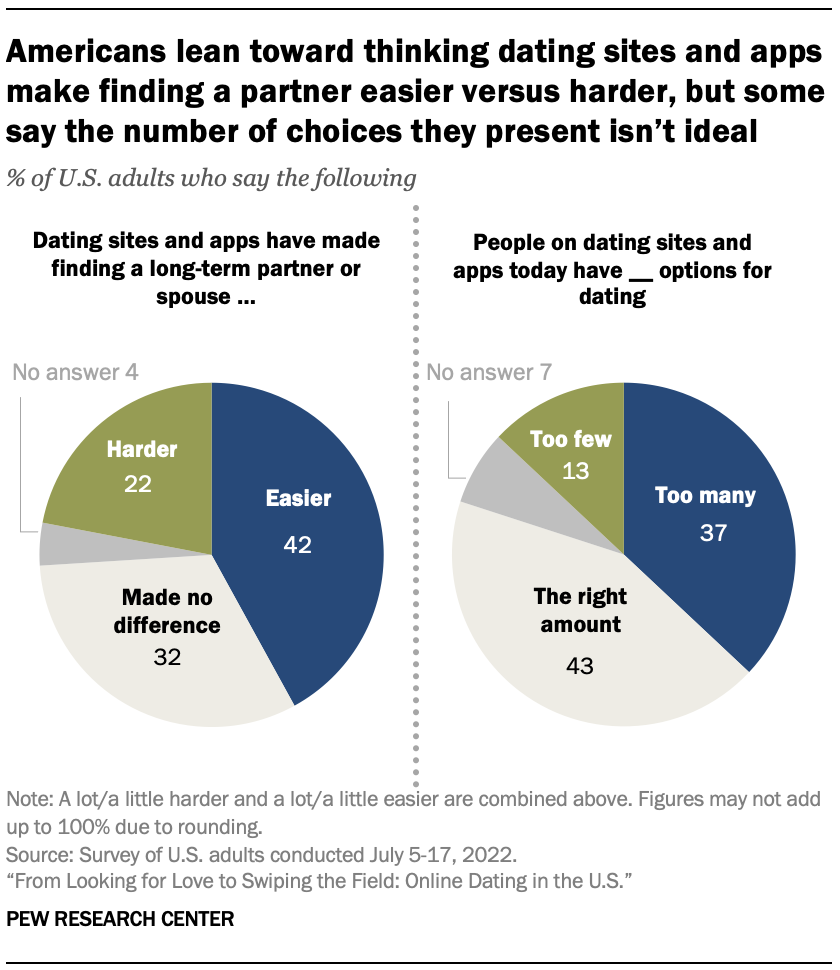
Asked about their perceptions of online dating – regardless of whether they have tried it or not – Americans overall see some positives: People tend to think these platforms make finding a partner easier rather than harder, though about a third say it has made no difference. Views on the choices these platforms provide are mixed, with about four-in-ten each saying they present too many choices or that it’s the right amount. About one-in-ten say they present too few.
When it comes to online dating’s overall impact on dating and relationships, people are relatively ambivalent, as was the case in 2019. Americans are about as likely to say online dating’s impact has been mostly negative (21%) as mostly positive (18%). But the majority (59%) say the impact of dating sites and apps has been neither positive nor negative, up from the share who said this in 2019 (50%).
Men and women differ in their views of online dating’s safety
Even as more Americans think these platforms have made finding a partner easier than harder, safety remains a top-of-mind issue for the public. Lawmakers and law enforcement alike have warned about potential risks of meeting people on dating platforms. At the same time, companies that run the platforms have voiced a commitment to safety by rolling out features to protect daters.
Americans are about evenly split on whether online dating is safe for meeting people or not – 49% say not at all or not too safe, while 48% say very or somewhat safe. Overall, the share of Americans who say online dating is safe for meeting people is down slightly from the last time the Center studied this in 2019 – from 53% to 48%.
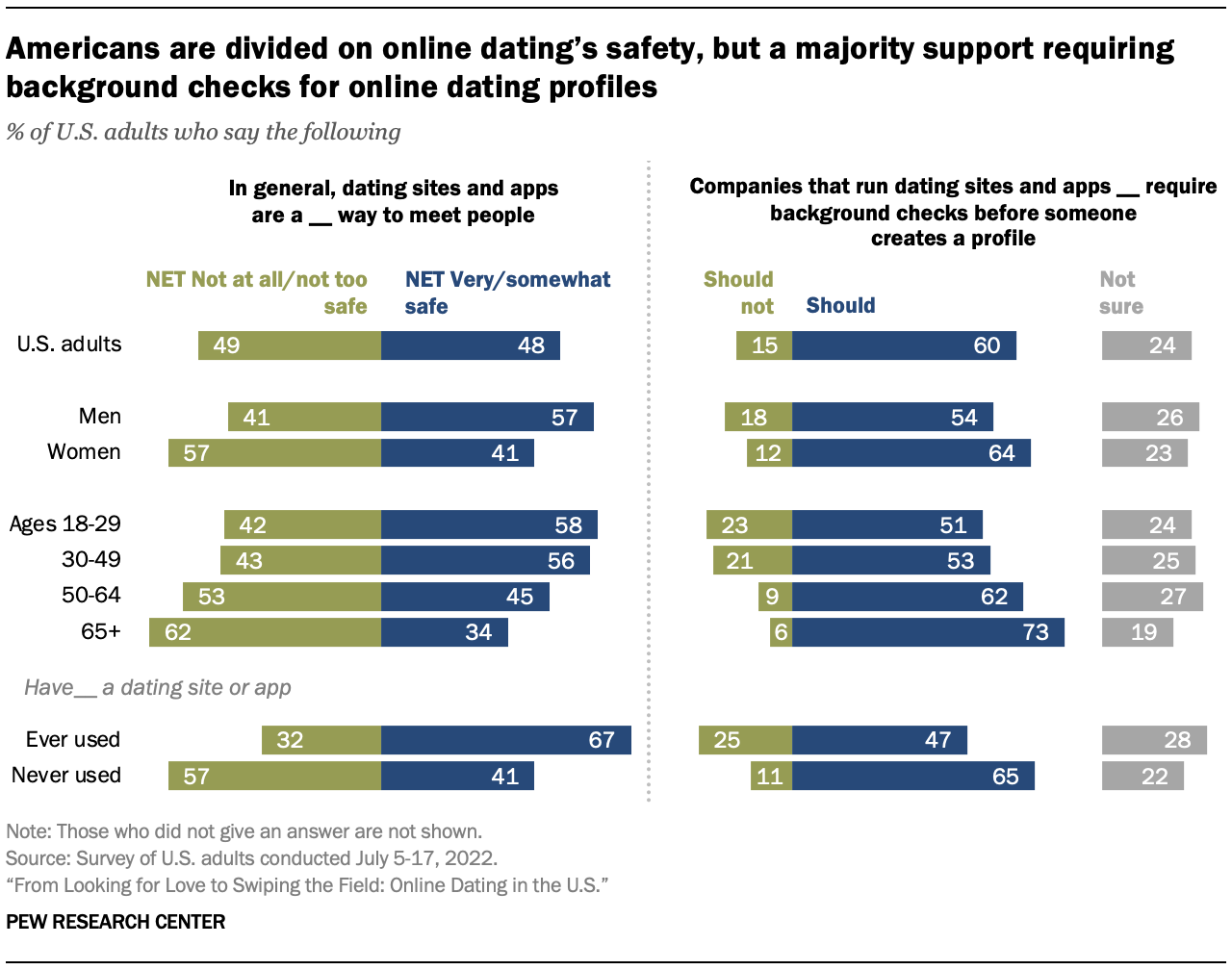
Women are more concerned about safety than men, with a majority of women (57%) saying dating sites and apps are not a safe way to meet people.
Views on safety also vary by age. Some 56% of adults under 50 say the platforms are a safe way to meet people versus smaller shares of those ages 50 to 64 (45%) and 65 and older (34%).
Mirroring the overall dip in perceptions of safety, there are comparable, slight declines in the shares of some demographic groups who say online dating is safe since 2019 – including women (down 5 percentage points from 46%) and Americans 65 and older (down 6 points from 40%).
Those who have ever been on a dating site or app are also more likely to think these sites are a safe way to meet people than those who have not used one (67% vs. 41%). But just as with Americans overall, there are deep divides among online dating users by demographics in perceptions of safety. For example, among those who have used a dating site or app, women are far more likely than men to say these platforms are not a safe way to meet people (41% vs. 23%).
In light of safety considerations, dating platforms have started to offer background checks for users who want to know more about someone they match with – but while some argue these precautions can protect users, others believe they have downsides. The survey explored how Americans feel about a related step dating sites and apps might take – requiring background checks before someone creates a profile.
Requiring background checks has majority support in the survey: Six-in-ten adults say companies that run dating sites and apps should require background checks before someone creates a profile. Still, 15% say companies should not do this and 24% are not sure what they think.
Views vary by demographics like gender and age. Women are 10 points more likely than men to say companies that run dating platforms should require background checks. And while 53% of adults under 50 favor this, that share rises to 62% among those 50 to 64 and 73% among those ages 65 and older.
These background checks also have greater support among those concerned about safety: Roughly seven-in-ten of those who think online dating is not a safe way to meet people say companies should require these types of checks, versus a smaller share of those who say it’s at least somewhat safe (71% vs. 49%).
Still, background checks do not have majority support among online dating users, themselves. Those who have ever used a dating site or app are less likely to say companies should require background checks in order to be on the apps compared with those who have not used the platforms (47% vs. 65%).

